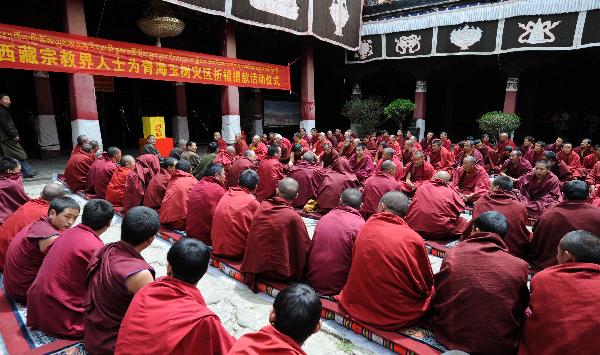Mass Praying Held in Quake-hit Yushu
 |
|
Tibetan Buddhist monks prayed at Jokhang Temple for blessings for quake-affected people of Qinghai Province and donated for the victims |
More than 120 monks from the Thrangu Monastery in China's quake-hit zone of Yushu held a mass prayer service to mourn the dead on April 28th.
It was the largest religious activity ever held in the Tibetan autonomous prefecture, since the 7.1-magnitude earthquake jolted the area on April 14, local officials said.
On grassland near the airport of Yushu, Qinghai Province, the monks sat on the ground and chanted prayers.
Lodroe Nyima Rinpoche, the living Buddha of the monastery, said before the service that it was being held to mourn the quake victims and to pay tribute to soldiers who helped the monks in the rescue and the recovery of religious observances.
The 700-year-old monastery was almost completely destroyed by the 7.1-magnitude earthquake and aftershocks, in which at least 2,220 people have been confirmed dead.
A row of prefabricated wooden homes and tents dotting the grassland make up of the temporary settlement for the monastery's monks.
Twenty-one of 230 monastery monks died in the quake.
The monks living in the "tent temple" of Thrangu are among more than 100,000 people left homeless by the quake. Eighty-seven of Yushu's 238 monasteries were damaged, with the Thrangu Monastery and two others completely destroyed, according to the rescue headquarters.
After the service, about 50 young monks wearing crimson robes, aged from 8 to 15, streamed into a makeshift classroom in a tent. They practiced prayers in their first religious class since the quake.
"Like we did before the earthquake, we chanted the sutra of Manjusri Bodhisattva who stands for wisdom," said teacher Kempo Chenli Basong.
"It has been 14 days since our last class," he said, adding the daily curriculum would resume from April 29th.
Lodroe Nyima Rinpoche said the recovery of the prayer service and the classes indicated life for the monks was getting back on track.
Leshi, chief of the ethnic and religious affairs committee of the Tibetan Autonomous Prefecture of Yushu, said that according to Tibetan Buddhism belief, the first 49 days after a disaster was a period of intensified prayers to guide the souls of the deceased.
In this way, religious activities in monasteries would be more frequent than those before the quake in spite of the damage, he said.
Kampo Chenli Basong, the teacher in the Thrangu Monastery, said that without a new temple with religious instruments, it was difficult to hold a mass assembly for believers, although routine observances had resumed.
"It may take three years to build a new monastery," he said.
Leshi said that repairs to the quake-damaged monasteries would be one of the priorities in relief and rebuilding efforts this year.
"By the end of this year, we hope to restore the living quarters of the monasteries for more than 8,000 monks now living in tents," he said.
(Source: Xinhua)
| 